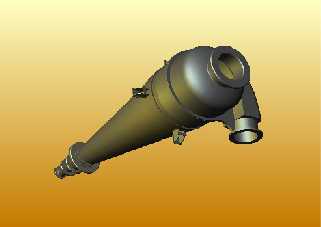Cyclone
The cyclone can handle a large range of fluid flow capacity. Cyclonic separation is a method of removing particles from air, gas, or liquid streams by vortex separation without the use of a filter. Turbine effects and gravity are applied to separate solid and fluid mixtures. It can also be used to separate fine droplets from the airflow. In some cases, a cyclone could replace a vertical two-phase separator.
Cyclones are used to separate solid particles from suspended solids by centrifugal sedimentation principle. The structure and working principle of the cyclone separator are shown in the figure. The main body of the device is composed of two parts: cylinder and cone. The suspending liquid enters the cylinder tangentially through the inlet pipe and moves downward in spiral. The solid particles are thrown to the wall by the inertial centrifugal force and descend to the outlet of the cone bottom with the down swirl flow. The liquid with high concentration discharged from the bottom is called the bottom flow. Clean liquid or liquid containing fine particles becomes the rising inner swirl and is discharged from the central tube at the top, it is known as overflow.
At the center of the inner swirl is an air column with negative pressure, the air is released from the slurry or intake of air due to exposure of the overflow nozzle to the atmosphere.
The cyclone separator is characterized by small cylinder diameter and long cone part. The cylinder with small diameter could increase the inertial centrifugal force to improve the sedimentation rate. At the same time, the extension of the conical part can increase the flow distance and prolong the detention time of the suspending liquid in the vessel.
In the cyclone separator, the rapid movement of solid particles along the wall will cause serious wear and tear. In order to prolong the service life, the material of construction shall be wear-resistant or wear-resistant material be used as lining.
Advantages of cyclone
Cyclone separators have the following advantages:
1. Reduce the number of tests required, thus saving time and money.
2. Optimal cyclone geometry could be obtained after optimization studies, or making selection from existing cyclones.
3. The separation efficiency and pressure drop can be predicted under non-computational conditions.


